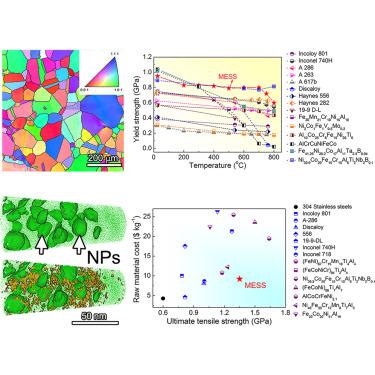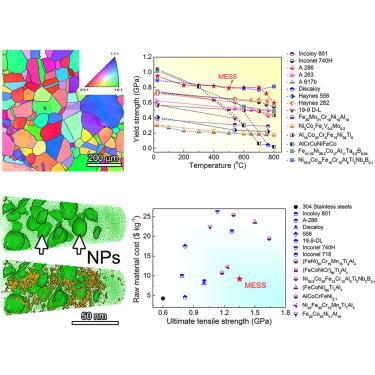发现一种新型低成本中熵不锈钢,在宽温度范围内具有优异的机械性能
IF 17.3
1区 材料科学
Q1 MATERIALS SCIENCE, MULTIDISCIPLINARY
引用次数: 0
摘要
不锈钢会出现强度-电导率折衷和高温强度不足的问题。在此,我们报告了一种新型低成本、无钴、Fe47Cr16Ni26Ti6Al5 中熵不锈钢(MESS),这种钢由高密度相干 L12 纳米沉淀物(NPs)强化,在室温(RT)下具有 1.35 GPa 的高极限抗拉强度和 36% 的总伸长率。韧性 L12 NPs 与变形亚结构的动态细化共同作用,产生了出色的加工硬化能力。此外,MESS 在 700°C 时的屈服强度高达 0.8 GPa,不仅优于许多铁基超耐热合金和不锈钢,而且与某些镍基超耐热合金相当。750°C 时的稳态蠕变速率比某些镍基超合金和耐热钢至少低两个数量级。优异的抗蠕变性是通过滑动位错与稳定的 L12 NPs 之间的强烈相互作用实现的,这种作用有效地阻碍了位错的移动。本文章由计算机程序翻译,如有差异,请以英文原文为准。


Discovery of a novel low-cost medium-entropy stainless steel with exceptional mechanical behavior over a wide temperature range
Stainless steels exhibit strength-ductility trade-off and insufficient elevated-temperature strength. Here, we report a novel low-cost, cobalt-free, Fe47Cr16Ni26Ti6Al5 medium-entropy stainless steel (MESS) strengthened by high-density coherent L12 nanoprecipitates (NPs) with a high ultimate tensile strength of 1.35 GPa and a total elongation of 36% at room temperature (RT). The ductile L12 NPs working together with the dynamic refinement of the deformation substructures cause an excellent work-hardening ability. Furthermore, the MESS maintains a high yield strength of ∼0.8 GPa at 700°C, which is not only better than many iron-based superalloys and stainless steels but also comparable to some nickel-based superalloys. The steady-state creep rates at 750°C are at least two orders of magnitude lower than those of some nickel-based superalloys and heat-resistant steels. The excellent creep resistance is achieved via the strong interactions between sliding dislocations and stable L12 NPs, which effectively impede the movement of dislocations.
求助全文
通过发布文献求助,成功后即可免费获取论文全文。
去求助
来源期刊

Matter
MATERIALS SCIENCE, MULTIDISCIPLINARY-
CiteScore
26.30
自引率
2.60%
发文量
367
期刊介绍:
Matter, a monthly journal affiliated with Cell, spans the broad field of materials science from nano to macro levels,covering fundamentals to applications. Embracing groundbreaking technologies,it includes full-length research articles,reviews, perspectives,previews, opinions, personnel stories, and general editorial content.
Matter aims to be the primary resource for researchers in academia and industry, inspiring the next generation of materials scientists.
 求助内容:
求助内容: 应助结果提醒方式:
应助结果提醒方式:


